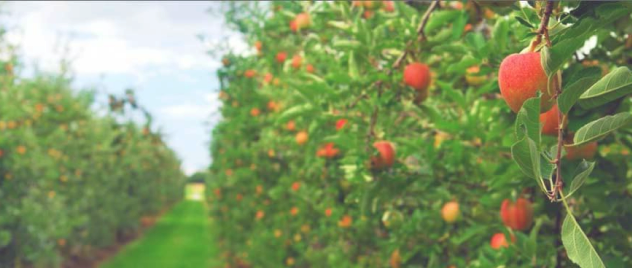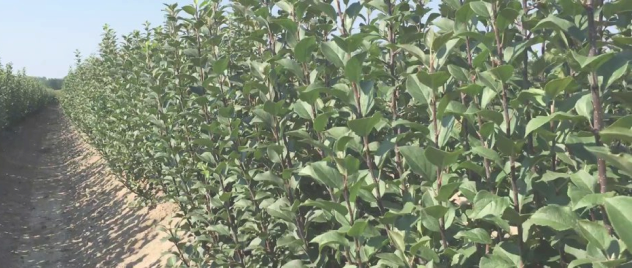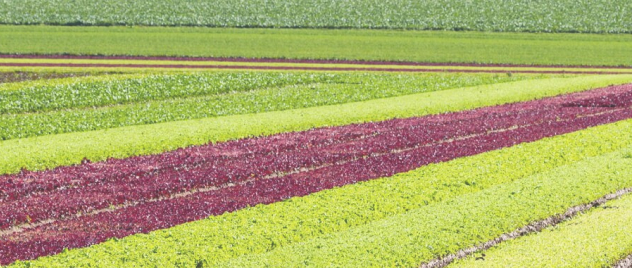GOOSEBERRIES
Gooseberry (Ribes uva-crispa) is a small fruit-bearing shrub that belongs to the Grossulariaceae family. It is native to Europe, Asia, and North Africa and is known for its tart and tangy berries. Gooseberries can be enjoyed fresh, used in jams, jellies, pies, desserts, and even in savory dishes. This fruit is highly nutritious, packed with vitamin C, antioxidants, minerals, proteins, omega-3 fatty acids and dietary fiber. The gooseberry bush is deciduous and features lobed leaves and thorny branches. The berries come in various colors, including green, red, yellow, and purple, and they are prized for their unique flavor and culinary versatility.
GOOSEBERRY
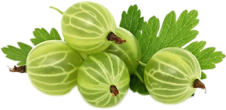
CULTIVATION
Gooseberries thrive in cool temperate climates and are well-suited for regions with distinct seasons. They prefer well-drained soil and full to partial sun exposure for optimal growth. Gooseberry bushes are relatively low-maintenance and can tolerate a wide range of soil conditions, including loam, clay, or sandy soil. Proper pruning is essential to maintain plant vigor, shape the bush, and maximize fruit production. These hardy shrubs can withstand cold winters and are known to be resistant to various diseases and pests.
GROWING SYSTEMS
Gooseberry bushes are typically upright and compact, growing to a height of 1 to 1.5 meters (3 to 5 feet). They have a spreading habit, with branches extending outward from the main stem. The branches are often thorny, so care should be taken when handling the plants. The leaves are deeply lobed and rich green in color, creating an attractive foliage display throughout the growing season. Gooseberry bushes produce clusters of small berries that are either smooth or covered in fine hairs, depending on the variety. Gooseberries can be grown using different systems, depending on the available space, desired management practices, and the specific needs of the cultivar:
Bush System: The bush system is the most common method of growing gooseberries. In this system, the plants are allowed to grow naturally into a bushy form without any particular training. The branches develop from the base of the plant and spread outwards, creating a compact and rounded bush. This system is suitable for home gardens and smaller orchards.
Espalier System: The espalier system involves training the gooseberry plants to grow against a support structure, such as a trellis, fence, or wall. The branches are pruned and tied to the support in a horizontal or fan shape. This system allows for better air circulation, easier access for pruning and harvesting, and efficient use of space. Espaliered gooseberries are often used in ornamental gardens or in limited space situations.
TYPICAL SPACINGS
The spacing between gooseberry plants may vary depending on the growth habit of the specific cultivar, available space, and management practices. Here are some typical spacings for gooseberry plants:
Bush System: For the bush system, gooseberry plants are typically spaced between 1 to 1.5 meters (3 to 5 feet) apart in both the row and between rows. This spacing allows the plants to develop a bushy form and provides sufficient airflow and sunlight for each plant.
Espalier System: When growing gooseberries using the espalier system, the spacing between plants depends on the desired shape and structure. Typically, plants are spaced around 60 to 90 centimeters (2 to 3 feet) apart in the row and 2 to 2.5 meters (6 to 8 feet) between rows. Adjustments can be made based on the growth rate and vigor of the cultivar being grown.
It's important to consider the specific growth characteristics of the chosen gooseberry variety and adapt the spacing accordingly to ensure optimal growth, sunlight exposure, and airflow within the orchard or garden.
See our full SELECTION of GOOSEBERRY PLANTS we have in our offer
HINNONMAKI RED
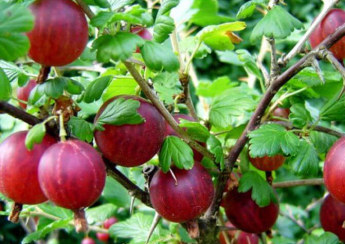
PLANT:
Hinnonmaki Rot gooseberry is a remarkable variety known for its compact growth and abundant fruit production. The plants are medium-sized with a dense and spreading habit, forming a low-growing mound. Hinnonmaki Rot gooseberry plants feature attractive dark green foliage that turns shades of vibrant red and orange in the fall, adding to their visual appeal. They are well-adapted to a variety of growing conditions and exhibit great tolerance to colder climates.
POLLINATORS:
Hinnonmaki Rot gooseberry is a self-pollinating variety. However, planting another compatible gooseberry variety nearby can enhance cross-pollination and potentially increase yields.
FRUIT APPEARANCE:
The Hinnonmaki Rot gooseberries are medium-sized with a striking deep red color. The berries grow in tight clusters and have a smooth skin, giving them a glossy appearance. They have a slightly tart flavor balanced with natural sweetness, making them ideal for both fresh consumption and culinary uses.
HARVEST:
Hinnonmaki Rot gooseberries are typically ready for harvest in late summer to early fall, usually from the first half of July. The berries ripen uniformly, allowing for efficient harvesting. Suitable for machine harvest. The plants offer a generous yield, ensuring an ample supply of these flavorful cranberries.
COMMERCIAL USE:
Hinnonmaki Rot gooseberries are highly valued for their exceptional flavor and versatility. They are perfect for enjoying fresh, used in sauces, or incorporated into a variety of culinary creations. Hinnonmaki Rot cranberries are also well-suited for juicing, preserving, and drying. With their compact growth habit, attractive foliage, and delicious flavor, Hinnonmaki Rot cranberries are a popular choice for both home gardeners and commercial growers seeking a reliable and flavorful gooseberry variety.
HINNONMAKI GREEN
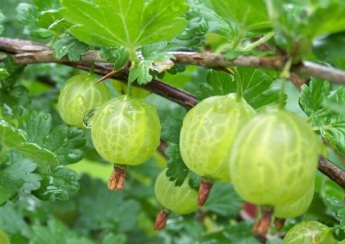
PLANT:
Hinnonmaki Green (Gron) gooseberry is a unique variety known for its compact growth and abundant fruit production. The plants are medium-sized with a dense and spreading habit, forming a low-growing mound. Hinnonmaki Green gooseberry plants feature attractive dark green foliage that turns shades of vibrant red and orange in the fall, adding to their visual appeal. They are well-adapted to a variety of growing conditions and exhibit great tolerance to cold climates, drought, and mildew.
POLLINATORS:
Hinnonmaki Gron gooseberry is a self-pollinating variety. However, planting another compatible gooseberry variety nearby can enhance cross-pollination and potentially increase yields.
FRUIT APPEARANCE:
he Hinnonmaki Green gooseberries are medium-sized with a unique light green color that matures to a pale yellow hue when fully ripe. The berries grow in tight clusters and have a smooth skin, giving them a glossy appearance. They have a slightly tart flavor balanced with natural sweetness, making them ideal for both fresh consumption and culinary uses.
HARVEST:
Hinnonmaki Gron gooseberries are typically ready for harvest in late summer to early fall, usually from mid-July. The berries ripen uniformly, allowing for efficient harvesting. Suitable for machine harvest. The plants offer a generous yield, ensuring an ample supply of these flavorful cranberries.
COMMERCIAL USE:
Hinnonmaki Green gooseberries are highly valued for their exceptional flavor and versatility. They are perfect for enjoying fresh, whether eaten as a healthy snack or used in a variety of culinary creations such as salads, sauces, and desserts. Hinnonmaki Green gooseberry can also be used for juicing, preserving, and adding a unique touch to beverages. With their compact growth habit, attractive foliage, and delicious flavor, Hinnonmaki Green cranberries are a popular choice for both home gardeners and commercial growers seeking a reliable and flavorful gooseberry variety.
SPINE FREE
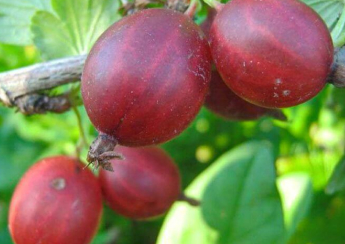
PLANT:
Spine Free gooseberry is a distinctive variety known for its unique feature of being devoid of thorns or spines. The plants are vigorous, medium-sized with a spreading growth habit, forming low-lying mats or mounds. Spine Free gooseberry plants feature attractive dark green foliage that transitions to shades of red and bronze in the fall, enhancing their ornamental value. They are well-suited to a variety of growing conditions and exhibit good tolerance to colder climates.
POLLINATORS:
Spine Free gooseberry is a self-pollinating variety. However, planting another compatible gooseberry variety nearby can enhance cross-pollination and potentially increase yields.
FRUIT APPEARANCE:
The Spine Free gooseberries are medium-sized with a rich red color when fully ripe. The berries grow in tight clusters and have a smooth skin, giving them a glossy appearance. They have a slightly tart flavor balanced with natural sweetness, making them ideal for both fresh consumption and culinary uses.
HARVEST:
Spine Free gooseberries are typically ready for harvest mid-late, usually from July through August. The berries ripen uniformly, allowing for efficient harvesting. Suitable for machine harvest. The plants offer a generous yield.
COMMERCIAL USE:
Spine Free gooseberries are highly valued for their exceptional flavor and unique feature of being thornless. They are perfect for enjoying fresh, whether eaten as a healthy snack or used in a variety of culinary creations such as sauces, jams, and desserts. Spine Free gooseberries can also be dried or used for decorative purposes. With their lack of spines, attractive foliage, and delicious flavor, Spine Free gooseberries are a sought-after choice for both home gardeners and commercial growers.

